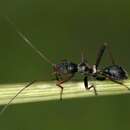en
names in breadcrumbs


Myrmecoris gracilis, auch als Ameisenwanze bezeichnet, ist eine Wanzenart aus der Familie der Weichwanzen (Miridae). Die Gattung Myrmecoris ist monotypisch mit nur einer paläarktisch verbreiteten Art von ameisenähnlicher Gestalt. Sie weicht in ihrem äußeren Erscheinungsbild und ihrer Lebensweise stark von den übrigen Vertretern der gemeinhin als „Graswanzen“ bezeichneten Gruppe der Stenodemini ab.
Das Verbreitungsgebiet von Myrmecoris gracilis umfasst das ganze nördliche und mittlere Europa sowie den Westen des nördlichen Mittelmeerraumes. Nach Osten ist sie bis Sibirien, China und Korea verbreitet. Die Wanze lebt an trocken-warmen bis mäßig feuchten, grasreichen Offenstandorten. Die erwachsenen Tiere können bei kühl-feuchter Witterung auf dem Boden herumlaufend oder an Gräsern und Kräutern hochkletternd beobachtet werden.
Die Wanzen werden vier bis sechs Millimeter lang. Die erwachsenen Insekten ähneln Ameisen der Gattung Formica, die Larven dunklen Lasius-Arten. Sie werden häufig gemeinsam mit Ameisen angetroffen, eine unmittelbare Beziehung zu dieser Tiergruppe besteht aber offenbar nicht. Ameisenwanzen ernähren sich zoophytophag, das heißt sowohl von Pflanzensäften als auch von anderen Insekten. Zu ihrem bevorzugten Beutespektrum gehören vor allem Blattläuse, aber auch anderen kleine Arthropoden und deren Eier; gelegentlich nehmen sie Honigtau zu sich. Ihre Ernährungsweise steht damit im Gegensatz zu der von „Graswanzen“ (Stenodemini), die reine Phytophage sind. Larven von Ameisenwanzen schlüpfen im Mai, die erwachsenen Tiere sind dann von Anfang Juni bis Anfang August zu finden. Beide Geschlechter sind meist kurzflüglig (brachypter), selten treten langflüglige (makroptere) Individuen auf. Ameisenwanzen bilden eine Generation pro Jahr aus. Die Eier werden von den Weibchen in älteren Grashalmen versenkt und überwintern dort.
Myrmecoris gracilis, auch als Ameisenwanze bezeichnet, ist eine Wanzenart aus der Familie der Weichwanzen (Miridae). Die Gattung Myrmecoris ist monotypisch mit nur einer paläarktisch verbreiteten Art von ameisenähnlicher Gestalt. Sie weicht in ihrem äußeren Erscheinungsbild und ihrer Lebensweise stark von den übrigen Vertretern der gemeinhin als „Graswanzen“ bezeichneten Gruppe der Stenodemini ab.
Myrmecoris gracilis is a species of flightless Hemipteran bug from the family Miridae. The genus Mymecoris is monotypic with one Palaearctic species. It differs in its outward appearance and way of life from other "grass bugs" in the Stenodemini,[3] being predatory and an effective ant mimic.[4]
The bugs are four to six millimeters long. The adult insects resemble ants of the genus Formica, the larvae dark Lasius ant species.[3] They are often found together with ants, to which they have a convincing but superficial resemblance. The long rostrum is held inconspicuously beneath the head.[4]
The bugs suck plant juices, but feed mainly on aphids, other small insects and insect eggs, sometimes on honeydew, unlike other "grass bugs" (Stenodemini) which are exclusively herbivorous. The larvae hatch in May. The adults can be found from early June to early August. There is one generation a year. The overwintering eggs are buried in older blades of grass. Both sexes are usually flightless but some winged individuals occur.[3]
The generic name is from Greek myrmex, ant, and koris, beetle or bug. The specific name is the Latin for slender or graceful.
Myrmecoris gracilis is found across the whole of northern and central Europe, as well as the western part of the northern Mediterranean.[3] To the east it is common in Siberia, China and Korea. The bug lives on dry and warm to moderately damp, grassy open habitats. The adults can be seen climbing on grasses and herbaceous plants in cool damp weather.[3]
The species was formerly classed by the IUCN as "Rare" in its pre-1994 system; in the UK, the species had been recorded in 15 ten-kilometre squares or fewer at that time.[5] It is described as a "not common" inhabitant of dry heathland in Britain, where it is confined to the far south of England in an area bounded by Exeter, Bristol, Oxford, Luton and Eastbourne.[4] In the Avon Gorge it forms 11.1% of the insect visitors to Trinia glauca.[6]
Myrmecoris gracilis is a species of flightless Hemipteran bug from the family Miridae. The genus Mymecoris is monotypic with one Palaearctic species. It differs in its outward appearance and way of life from other "grass bugs" in the Stenodemini, being predatory and an effective ant mimic.
La chinche hormiga (Myrmecoris gracilis) es una especie de hemíptero heteróptero de la familia Miridae. Es la única especie del género Myrmecoris.
Miridido de pequeño tamaño, entre 40 y 60 mm, para identificarla y comprobar que se trata de una chinche hay que observar detenidamente la trompa suctora. Aspecto, movimientos y olor tan parecidos a la hormiga que esta no la reconoce como distinta.
Se distribuye por casi toda Europa, siendo regular y frecuente, habitando en los bosques mixtos de fronda. Se alimentan exclusivamente de pulgones, los huevos invernan entre la hojarasca y las ninfas aparecen en primavera y son casi idénticas a las chinches adultas, tanto las ninfas como las adultas viven en sociedad con las hormigas.
La chinche hormiga (Myrmecoris gracilis) es una especie de hemíptero heteróptero de la familia Miridae. Es la única especie del género Myrmecoris.
Sipelglutikas (Myrmecoris gracilis) lutikaliste alamseltsi kuuluv putukaliik.
Putukat on ka Eestis.[1]
Sipelglutikas (Myrmecoris gracilis) lutikaliste alamseltsi kuuluv putukaliik.
Putukat on ka Eestis.